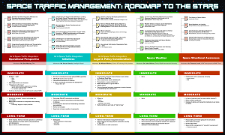Start Date
12-11-2015 1:00 PM
Abstract
Launch Vehicle/Reentry Vehicle (LV/RV) operations are expected to increase across the National Airspace System (NAS) as their reliability and availability improve. LV/RV designs and the industry landscape have vastly changed since the 1960’s, and the Federal Aviation Administration’s (FAA) methods for handling these operations need to evolve to support the expected growth. Currently, large amounts of airspace are segregated for every LV/RV operation. This increases costs for NAS users and may limit LV/RV opportunities. The FAA’s NextGen office recently proposed two more efficient separation concepts for LV/RV operations called Space Transition Corridors, and Four-Dimensional Trajectory Deconfliction. Prior safety research for LV/RV separation concepts has been limited to the interactions between falling debris and aircraft during in-flight breakup. However, there have been limited studies on the interactions between aircraft and LV/RV, aircraft and aircraft, and impacts on controller workload for LV/RV separation concepts and standards. Understanding these interactions is critical to implementing more efficient separation concepts and standards. The MITRE Corporation (MITRE) is building a flexible, fast-time modeling and simulation capability that fills this gap and provides operational measures of safety for each type of LV/RV operation using different separation concepts and associated standards, which helps support the FAA’s Safety Management System process. This capability will allow the FAA to determine which separation concepts meet a target level of safety for each type of LV/RV operation and will provide insight into the required surveillance performance, air traffic control and pilot response times, and traffic limits to enable the concepts. This paper describes the research, modeling, and current progress of MITRE’s analytic capability.
Area of Interest
NAS Integration
Nov 12th, 1:00 PM
Evaluating Launch Vehicle / Reentry Vehicle (LV/RV) Separation Concepts
Launch Vehicle/Reentry Vehicle (LV/RV) operations are expected to increase across the National Airspace System (NAS) as their reliability and availability improve. LV/RV designs and the industry landscape have vastly changed since the 1960’s, and the Federal Aviation Administration’s (FAA) methods for handling these operations need to evolve to support the expected growth. Currently, large amounts of airspace are segregated for every LV/RV operation. This increases costs for NAS users and may limit LV/RV opportunities. The FAA’s NextGen office recently proposed two more efficient separation concepts for LV/RV operations called Space Transition Corridors, and Four-Dimensional Trajectory Deconfliction. Prior safety research for LV/RV separation concepts has been limited to the interactions between falling debris and aircraft during in-flight breakup. However, there have been limited studies on the interactions between aircraft and LV/RV, aircraft and aircraft, and impacts on controller workload for LV/RV separation concepts and standards. Understanding these interactions is critical to implementing more efficient separation concepts and standards. The MITRE Corporation (MITRE) is building a flexible, fast-time modeling and simulation capability that fills this gap and provides operational measures of safety for each type of LV/RV operation using different separation concepts and associated standards, which helps support the FAA’s Safety Management System process. This capability will allow the FAA to determine which separation concepts meet a target level of safety for each type of LV/RV operation and will provide insight into the required surveillance performance, air traffic control and pilot response times, and traffic limits to enable the concepts. This paper describes the research, modeling, and current progress of MITRE’s analytic capability.










Comments
Zheng Tao’s Bio
Approved for Public Release; Distribution Unlimited. 15-2481 ©2015 The MITRE Corporation. ALL RIGHTS RESERVED. Disclaimer: The contents of this material reflect the views of the author and/or the Director of the Center for Advanced Aviation System Development. Neither the Federal Aviation Administration nor the Department of Transportation makes any warranty or guarantee, or promise, expressed or implied, concerning the content or accuracy of the views expressed herein.